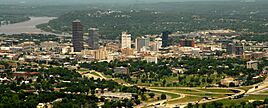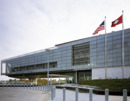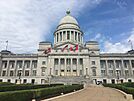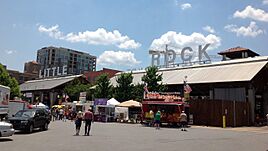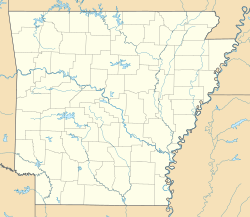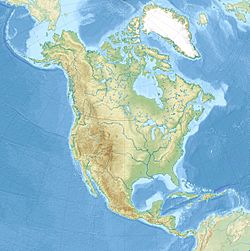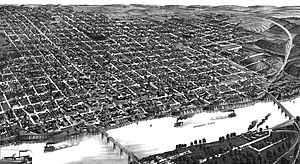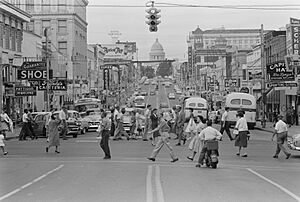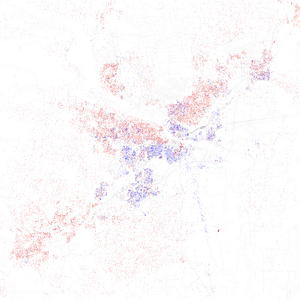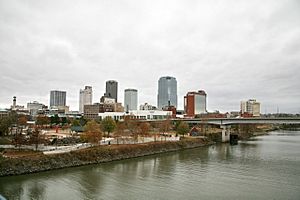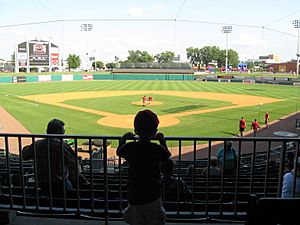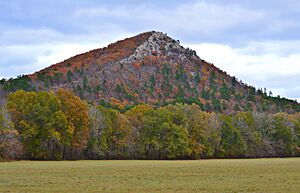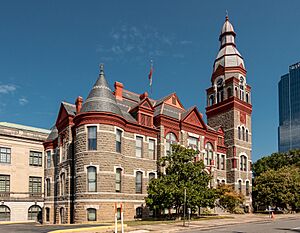Little Rock, Arkansas facts for kids
Quick facts for kids
Little Rock
|
|||||
|---|---|---|---|---|---|
|
Downtown Little Rock
War Memorial Stadium
|
|||||
|
|||||
| Nicknames:
The Rock, Rock Town, LR
|
|||||
| Country | United States | ||||
| State | Arkansas | ||||
| County | Pulaski | ||||
| Founded | June 1, 1821 | ||||
| Incorporated (town) | November 7, 1831 | ||||
| Incorporated (city) | November 2, 1835 | ||||
| Named for | The Little Rock | ||||
| Government | |||||
| • Type | Council–manager | ||||
| • Body | Little Rock Board of Directors | ||||
| Area | |||||
| • State capital city | 123.00 sq mi (318.58 km2) | ||||
| • Land | 120.05 sq mi (310.92 km2) | ||||
| • Water | 2.96 sq mi (7.66 km2) | ||||
| • Metro | 4,090.34 sq mi (10,593.94 km2) | ||||
| Elevation | 279 ft (85 m) | ||||
| Population
(2020)
|
|||||
| • State capital city | 202,591 | ||||
| • Rank | US: 121st | ||||
| • Density | 1,687.60/sq mi (651.58/km2) | ||||
| • Urban | 461,864 (US: 87th) | ||||
| • Urban density | 1,724.6/sq mi (665.9/km2) | ||||
| • Metro | 748,031 (US: 81st) | ||||
| Demonym(s) | Little Rocker | ||||
| Time zone | UTC−06:00 (CST) | ||||
| • Summer (DST) | UTC−05:00 (CDT) | ||||
| ZIP code(s) |
72201-72207, 72209-72212, 72214-72217, 72219, 72221-72223, 72225, 72227, 72231, 72255, 72260, 72295
|
||||
| Area code(s) | 501 | ||||
| FIPS code | 05-41000 | ||||
| GNIS feature ID | 2404939 | ||||
Little Rock is the capital city of Arkansas, a state in the United States. It is also the most populated city in Arkansas. In 2020, about 202,591 people lived there. The larger Little Rock metropolitan area has around 770,000 residents. This makes it the 81st largest metropolitan area in the U.S. The city is located on the south bank of the Arkansas River. It is near the center of the state. Little Rock is the main city of Pulaski County.
Little Rock became the capital of the Arkansas Territory in 1821. Its name comes from a small rock formation along the Arkansas River. A French explorer named Jean-Baptiste Bénard de la Harpe called it "the Little Rock" in 1722. The city is famous for its role in the Civil Rights movement. This includes the Little Rock Nine event in 1957. Today, Little Rock is an important center for culture, business, government, and transportation in Arkansas and the American South.
The city's economy relies on several areas. These include healthcare, banking, transportation, and shopping. Big companies like Dillard's and Windstream Holdings have their main offices here. The University of Arkansas for Medical Sciences is also a major part of the healthcare and research scene. You can visit cultural spots like the Arkansas Museum of Fine Arts and the Clinton Presidential Center. For outdoor fun, there's the Arkansas River Trail and Pinnacle Mountain State Park.
Contents
- History of Little Rock
- Geography of Little Rock
- People of Little Rock
- Economy and Business in Little Rock
- Arts and Culture in Little Rock
- Sports in Little Rock
- Parks and Recreation in Little Rock
- Government of Little Rock
- Education in Little Rock
- Media in Little Rock
- Transportation in Little Rock
- Healthcare in Little Rock
- Notable People from Little Rock
- Sister Cities of Little Rock
- See also
History of Little Rock
How Little Rock Got Its Name
Little Rock gets its name from a special rock on the bank of the Arkansas River. Early travelers used this rock as a landmark. It showed where the flat Mississippi Delta ended and the Ouachita Mountains began. A French explorer, Jean-Baptiste Bénard de la Harpe, named it "the Little Rock" in 1722.
People started calling the area "Little Rock." Even though some tried to name the city "Arkopolis" when it was founded in the 1820s, the name Little Rock stuck.
Becoming the Capital City
Before Little Rock, the capital of Arkansas was Arkansas Post. But that location often flooded, which made it hard to live there. In 1820, people wanted to move the capital. Many important people bought land around the "little rock." So, in October 1820, the government decided to move the capital to Little Rock. It has been the capital ever since.
The Little Rock Nine and Civil Rights
The Little Rock Nine were nine brave African American students. In 1957, they helped end segregation at Little Rock Central High School. Segregation meant that black and white students went to separate schools. The school board had voted to start letting all students attend together. This was part of the Brown v. Board of Education ruling.
On September 4, 1957, the first day of school, a group of people tried to stop the nine black students from entering. The governor of Arkansas, Orval Faubus, even sent the Arkansas National Guard to block them. But a judge ordered the Guard to leave.
When the students finally entered, angry crowds caused problems. President Dwight D. Eisenhower then sent U.S. soldiers to Little Rock. These soldiers from the 101st Airborne Division protected the students. They made sure the students could safely go to school.
The public high schools in Little Rock closed for a year in 1958. They reopened in 1959. All schools in Little Rock were fully integrated by 1972. This event at Little Rock Central High School showed the world the challenges African Americans faced in the U.S.
Geography of Little Rock
Little Rock is located on the south side of the Arkansas River. This is in the central part of Arkansas. Two creeks, Fourche Creek and Rock Creek, flow through the city into the river. The western part of Little Rock is in the foothills of the Ouachita Mountains. Just northwest of the city, you'll find Pinnacle Mountain and Lake Maumelle. Lake Maumelle is where Little Rock gets its drinking water.
The city of North Little Rock is right across the river. But it is a separate city. It used to be part of Little Rock.
Little Rock's Neighborhoods
Little Rock has many different neighborhoods. Some of the well-known ones include:
- Applegate
- Birchwood
- Breckenridge
- Briarwood
- Broadmoor
- Bryce's Creek
- Capitol-Main Historic District
- Capitol View/Stifft's Station
- Central High School Historic District
- Chenal Valley
- Cloverdale
- Colony West
- Downtown
- Echo Valley
- East End
- Fair Park
- Geyer Springs
- Governor's Mansion
- Granite Mountain
- Gum Springs
- Hanger Hill
- Hall High
- The Heights
- Highland Park
- Hillcrest
- John Barrow
- Kingwood
- Leawood
- Mabelvale
- MacArthur Park
- Marshall Square
- Otter Creek
- Pankey
- Paul Laurence Dunbar School
- Pinnacle Valley
- Pleasant Valley
- Pulaski Heights
- Quapaw Quarter
- Riverdale
- Robinwood
- Rosedale
- Scott Street
- St. Charles
- South End
- South Main Street (apartments)
- South Main Street (residential)
- South Little Rock
- Southwest Little Rock
- Stagecoach
- Sturbridge
- University Park
- Walnut Valley
- Walton Heights
- Wakefield
- West End
- Woodlands Edge
Little Rock's Climate
Little Rock has a humid subtropical climate. This means it has hot, humid summers. Winters are cool, but usually don't get much snow. The lowest temperature ever recorded was −12°F (−24°C) in 1899. The highest was 114°F (46°C) in 2011.
| Climate data for Little Rock (Little Rock Nat'l Airport), 1981−2010 normals, extremes 1875−present | |||||||||||||
|---|---|---|---|---|---|---|---|---|---|---|---|---|---|
| Month | Jan | Feb | Mar | Apr | May | Jun | Jul | Aug | Sep | Oct | Nov | Dec | Year |
| Record high °F (°C) | 83 (28) |
87 (31) |
91 (33) |
95 (35) |
98 (37) |
107 (42) |
112 (44) |
114 (46) |
106 (41) |
97 (36) |
86 (30) |
80 (27) |
114 (46) |
| Mean daily maximum °F (°C) | 50.5 (10.3) |
55.1 (12.8) |
64.0 (17.8) |
73.1 (22.8) |
81.1 (27.3) |
88.9 (31.6) |
92.5 (33.6) |
92.6 (33.7) |
85.6 (29.8) |
74.8 (23.8) |
63.0 (17.2) |
52.3 (11.3) |
72.8 (22.7) |
| Daily mean °F (°C) | 40.8 (4.9) |
44.8 (7.1) |
53.4 (11.9) |
62.1 (16.7) |
71.1 (21.7) |
79.1 (26.2) |
82.8 (28.2) |
82.5 (28.1) |
75.0 (23.9) |
63.7 (17.6) |
52.6 (11.4) |
43.0 (6.1) |
62.6 (17.0) |
| Mean daily minimum °F (°C) | 31.2 (−0.4) |
34.5 (1.4) |
42.7 (5.9) |
51.0 (10.6) |
61.1 (16.2) |
69.4 (20.8) |
73.2 (22.9) |
72.4 (22.4) |
64.5 (18.1) |
52.6 (11.4) |
42.2 (5.7) |
33.7 (0.9) |
52.4 (11.3) |
| Record low °F (°C) | −8 (−22) |
−12 (−24) |
11 (−12) |
28 (−2) |
38 (3) |
46 (8) |
54 (12) |
52 (11) |
37 (3) |
27 (−3) |
10 (−12) |
−1 (−18) |
−12 (−24) |
| Average precipitation inches (mm) | 3.55 (90) |
3.66 (93) |
4.68 (119) |
5.14 (131) |
4.87 (124) |
3.65 (93) |
3.27 (83) |
2.59 (66) |
3.18 (81) |
4.91 (125) |
5.28 (134) |
4.97 (126) |
49.75 (1,264) |
| Average snowfall inches (cm) | 1.6 (4.1) |
1.3 (3.3) |
0.4 (1.0) |
0 (0) |
0 (0) |
0 (0) |
0 (0) |
0 (0) |
0 (0) |
0 (0) |
trace | 0.2 (0.51) |
3.5 (8.9) |
| Average precipitation days (≥ 0.01 in) | 8.9 | 9.1 | 9.8 | 9.4 | 11.1 | 8.7 | 8.2 | 6.4 | 7.3 | 8.2 | 8.9 | 9.7 | 105.7 |
| Average snowy days (≥ 0.1 in) | 0.6 | 0.6 | 0.3 | 0 | 0 | 0 | 0 | 0 | 0 | 0 | 0 | 0.2 | 1.7 |
| Mean monthly sunshine hours | 180.9 | 188.2 | 244.5 | 276.7 | 325.3 | 346.2 | 351.0 | 323.0 | 271.9 | 251.0 | 176.9 | 166.2 | 3,101.8 |
| Percent possible sunshine | 58 | 62 | 66 | 71 | 75 | 80 | 80 | 78 | 73 | 72 | 57 | 54 | 70 |
| Source: NOAA (sun 1961−1990 at North Little Rock Airport), The Weather Channel | |||||||||||||
People of Little Rock
| Historical population | |||
|---|---|---|---|
| Census | Pop. | %± | |
| 1850 | 2,167 | — | |
| 1860 | 3,727 | 72.0% | |
| 1870 | 12,380 | 232.2% | |
| 1880 | 13,138 | 6.1% | |
| 1890 | 25,874 | 96.9% | |
| 1900 | 38,307 | 48.1% | |
| 1910 | 45,941 | 19.9% | |
| 1920 | 65,142 | 41.8% | |
| 1930 | 81,679 | 25.4% | |
| 1940 | 88,039 | 7.8% | |
| 1950 | 102,213 | 16.1% | |
| 1960 | 107,813 | 5.5% | |
| 1970 | 132,483 | 22.9% | |
| 1980 | 159,151 | 20.1% | |
| 1990 | 175,795 | 10.5% | |
| 2000 | 183,133 | 4.2% | |
| 2010 | 193,524 | 5.7% | |
| 2020 | 202,591 | 4.7% | |
| 2024 (est.) | 207,459 | 7.2% | |
| U.S. Decennial Census | |||
| Race / Ethnicity (NH = Non-Hispanic) | Pop 2000 | Pop 2010 | Pop 2020 | % 2000 | % 2010 | % 2020 |
|---|---|---|---|---|---|---|
| White alone (NH) | 98,904 | 90,297 | 85,401 | 54.01% | 46.66% | 42.15% |
| Black or African American alone (NH) | 73,679 | 81,572 | 81,339 | 40.23% | 42.15% | 40.15% |
| Native American or Alaska Native alone (NH) | 450 | 519 | 497 | 0.25% | 0.27% | 0.25% |
| Asian alone (NH) | 2,992 | 5,098 | 7,099 | 1.63% | 2.63% | 3.50% |
| Pacific Islander or Native Hawaiian alone (NH) | 43 | 54 | 69 | 0.02% | 0.03% | 0.03% |
| Other race alone (NH) | 150 | 277 | 761 | 0.08% | 0.14% | 0.38% |
| Mixed race or Multiracial (NH) | 2,026 | 2,631 | 6,958 | 1.11% | 1.36% | 3.43% |
| Hispanic or Latino (any race) | 4,889 | 13,076 | 20,467 | 2.67% | 6.76% | 10.10% |
| Total | 183,133 | 193,524 | 202,591 | 100.00% | 100.00% | 100.00% |
Population in 2020
As of the 2020 United States census, Little Rock had 202,591 people. There were 80,063 households and 45,577 families living in the city.
Population in 2010
In 2010, Little Rock had 193,524 people. About 48.9% were White, 42.3% were Black, and 2.7% were Asian. About 6.8% of the people were Hispanic or Latino.
There were 82,018 households. In 30.5% of these, children under 18 lived there. The average household had 2.30 people. The average family had 3.00 people.
The median age in the city was 34 years old. About 24.7% of the population was under 18.
Little Rock's Metropolitan Area
The larger area around Little Rock is called the Little Rock-North Little Rock-Conway, AR Metropolitan Statistical Area. In 2020, about 748,031 people lived here. This area includes several counties: Pulaski, Faulkner, Grant, Lonoke, Perry, and Saline. The biggest cities in this area are Little Rock, North Little Rock, Conway, Jacksonville, Benton, Sherwood, Cabot, Maumelle, and Bryant.
Economy and Business in Little Rock
Little Rock is home to many important businesses. Companies like Dillard's Department Stores, Windstream Communications, Acxiom, Simmons Bank, and Bank OZK have their main offices here. Other large companies, like Dassault Falcon Jet, also have a big presence.
Many large non-profit groups are also based in Little Rock. These include Winrock International, Heifer International, and the Clinton Foundation. The American Taekwondo Association and Arkansas Hospital Association are also here. Major employers include Blue Cross Blue Shield, Baptist Health Medical Center, and the UAMS.
The University of Arkansas for Medical Sciences (UAMS) is one of the state's largest public employers. It has over 10,552 employees. UAMS, along with Arkansas Children's Hospital and the Central Arkansas Veterans Healthcare System, brings about $5 billion to Arkansas each year.
Little Rock has a river port that is important for trade. It is a Foreign Trade Zone. This means it's easier for international companies, like LM Glasfiber from Denmark, to do business here. Little Rock also has a branch of the Federal Reserve Bank of St. Louis.
Arts and Culture in Little Rock
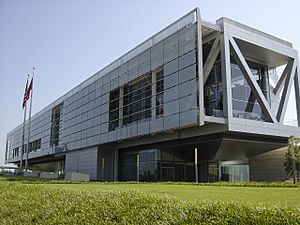
Little Rock offers many cultural experiences:
- The Quapaw Quarter is a historic area. It has many buildings listed on the National Register of Historic Places.
Museums to Explore
- The Arkansas Museum of Fine Arts is the state's largest cultural place. It has art and hosts many visual and performing arts events.
- The Museum of Discovery has hands-on exhibits. You can learn about science, history, and technology there.
- The William J. Clinton Presidential Center includes the library of former President Bill Clinton. It also has offices for the Clinton Foundation. The library has millions of photos, documents, and items from Clinton's time as president. It even has a full-size copy of the Oval Office.
- The Historic Arkansas Museum teaches about the state's early history.
- The MacArthur Museum of Arkansas Military History is in one of the oldest buildings in central Arkansas. It was the birthplace of General Douglas MacArthur.
- The Old State House Museum used to be the state capitol. Now it's a museum about Arkansas's recent history.
- The Mosaic Templars Cultural Center focuses on African American history and culture in Arkansas.
- The ESSE Purse Museum tells stories of American women through their handbags.
- Little Rock Central High School is still a school. But it also has a museum and visitor center about its important history.
Music and Theater Performances
- The Arkansas Repertory Theatre is the state's largest professional theater company. It puts on many plays each year.
- The Community Theatre of Little Rock is the oldest performing arts group in the area. It started in 1956.
- The Arkansas Symphony Orchestra performs over 30 concerts every year. Their main place to perform is the Robinson Center Music Hall.
- The Wildwood Park for the Arts is a large park for performing arts. It hosts festivals and cultural events.
Local Restaurants
Lassis Inn was a special meeting place for civil rights leaders in the 1950s and 1960s. People like Daisy Bates met there to plan important events. In 2020, it was named an America's Classic by the James Beard Foundation.
Sports in Little Rock
| Club | League | Venue | Established | Championships |
|---|---|---|---|---|
| Arkansas Travelers | Texas League | Dickey-Stephens Park | 1963 (played as the Little Rock Travelers from 1887 to 1961) | 7 |
| Little Rock Lightning | The Basketball League | Hall High School | 2020 | 0 |
| Little Rock Rangers | USL League Two | War Memorial Stadium | 2016 | 0 |
| Little Rock Trojans | NCAA Division I (Ohio Valley Conference) | Jack Stephens Center and Gary Hogan Field | 1927 | 3 |
| Arkansas Wolves FC | National Premier Soccer League | Scott Field | 2021 | 0 |
Little Rock is home to the Arkansas Travelers. They are a professional Minor League Baseball team. They are connected to the Seattle Mariners. The Travelers now play at Dickey–Stephens Park in nearby North Little Rock.
The Little Rock Rangers soccer club plays in the National Premier Soccer League. Their home games are at War Memorial Stadium.
The city is also home to the Little Rock Trojans. This is the sports program for the University of Arkansas at Little Rock. Their teams play in the Ohio Valley Conference.
War Memorial Stadium in Little Rock hosts at least one University of Arkansas Razorback football game each year. The stadium is unique because it's in the middle of a golf course. On game weekends, the golf course closes for fans to gather.
Little Rock also hosts the Little Rock Marathon. This race happens every year in March. It is known for giving the world's largest medal to people who finish the marathon.
Parks and Recreation in Little Rock
Little Rock has 48 parks for everyone to enjoy.
The biggest park in the area is Pinnacle Mountain State Park. It covers 2,000 acres around Pinnacle Mountain. The park also has the Arkansas Arboretum, which shows plants and trees from all of Arkansas's regions.
The Arkansas River Trail is a 17-mile path along the Arkansas River. It goes through Little Rock and over the Big Dam Bridge. This bridge is the longest pedestrian and bicycle bridge in North America.
The Little Rock Zoo started in 1926. It is home to at least 725 animals from over 200 different species.
Government of Little Rock
Little Rock has a city manager form of government. This means a city manager helps run the city's daily operations. The city also has a mayor who is elected by the people. The current mayor, elected in 2018, is Frank Scott Jr.. The city manager is Bruce T. Moore. Little Rock employs over 2,500 people in different departments. These include the police, fire, and parks departments.
Most of the Pulaski County government offices are in Little Rock. This includes courts and other important offices.
Education in Little Rock
Schools for Kids and Teens
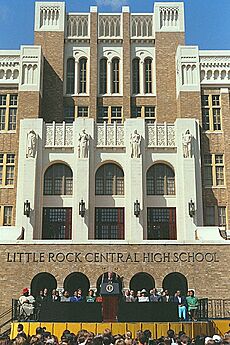
The Little Rock School District (LRSD) serves most of Little Rock. As of 2012, the district had 64 schools. In the 2009–2010 school year, about 25,685 students were enrolled. The district has five high schools: Little Rock Central High School, Little Rock Southwest High School, Little Rock West High School, Hall STEAM Magnet High School, and Parkview Arts and Science Magnet High School.
Parts of Little Rock are also served by the Pulaski County Special School District (PCSSD). Some of their high schools, like Mills University Studies High School and Joe T. Robinson High School, have Little Rock addresses.
Little Rock is also home to the Arkansas School for the Blind and the Arkansas School for the Deaf. These are state-run schools. There are also charter schools like eStem Public Charter High School and LISA Academy.
Many private schools are in Little Rock. These include Arkansas Baptist School System, Episcopal Collegiate School, Little Rock Catholic High School, and Mount Saint Mary Academy.
Colleges and Universities
Little Rock has two universities that are part of the University of Arkansas System. These are the University of Arkansas at Little Rock and the University of Arkansas for Medical Sciences (UAMS). UAMS has several colleges and research centers.
There are also two smaller colleges in Little Rock: Arkansas Baptist College and Philander Smith College. The Clinton School of Public Service is also here. It offers master's degrees in public service. Pulaski Technical College has two locations in Little Rock.
Libraries for Learning
The Central Arkansas Library System has a main building downtown. It also has many branches throughout the city and nearby towns. The Pulaski County Law Library is at the William H. Bowen School of Law.
Media in Little Rock
Newspapers and Magazines
The Arkansas Democrat Gazette is the largest newspaper in Little Rock and the state. It publishes a Sunday edition. Other publications include Arkansas Life magazine and Arkansas Business for business news.
Magazines covering different interests in the Little Rock area include:
- At Home in Arkansas
- AY Magazine
- Inviting Arkansas
- Little Rock Family
- Little Rock Soiree
- RealLIVING
Television Channels
Many TV networks have local channels in Little Rock.
| Call letters | Number | Network |
|---|---|---|
| KETS/AETN | 2 | PBS |
| KETS-2 | 2.2 | Create Arkansas Information Reading Service (audio only, only on SAP; radio reading service) |
| KETS-3 | 2.3 | PBS Kids |
| KETS-4 | 2.4 | World |
| KARK | 4 | NBC |
| Laff | 4.2 | Laff |
| Grit | 4.3 | Grit |
| Antenna TV | 4.4 | Antenna TV |
| KATV | 7 | ABC |
| KATV-DT2 | 7.2 | Comet TV |
| Charge! | 7.3 | Charge! |
| TBD | 7.4 | TBD |
| KTHV | 11 | CBS |
| THV2 | 11.2 | Court TV |
| Justice | 11.3 | Justice Network |
| Quest | 11.4 | Quest (U.S. TV network) |
| Circle | 11.5 | Circle (TV network) |
| Twist | 11.6 | Twist |
| KLRT | 16 | Fox |
| 16.2 | Escape | |
| KVTN | 25 | VTN: Your Arkansas Christian Connection |
| KASN | 38 | The CW |
| KKAP | 36 | Daystar |
| KARZ | 42 | MyNetworkTV |
| 42.2 | Bounce TV | |
| 42.3 | Ion Television | |
| KMYA-DT | 49.1 | Me-TV |
Transportation in Little Rock

Little Rock is served by major highways. Interstate 40 (I-40) goes through North Little Rock. I-30 comes into the city from the south. Other highways like I-430 and I-440 help traffic move around the city.
Rock Region Metro provides public bus service in Little Rock. They also run the Metro Streetcar system. This streetcar connects downtown Little Rock and North Little Rock. It's a 3.4-mile route with 14 stops.
For longer trips, Greyhound Lines and Jefferson Lines offer bus services. Amtrak also has train service twice a day. You can travel to Chicago or San Antonio by train.
Clinton National Airport serves Little Rock. Nine airlines fly from here to many cities across the country. In 2006, about 2.1 million passengers used the airport.
Healthcare in Little Rock
Hospitals in Little Rock include:
- Arkansas State Hospital – Psychiatric Division
- Arkansas Children's Hospital
- Arkansas Heart Hospital
- Baptist Health Medical Center
- Central Arkansas Veteran's Health care System (CAVHS)
- Pinnacle Pointe Hospital
- St. Vincent Health System
- UAMS Medical Center
Emergency medical services are provided by Metropolitan Emergency Medical Services (MEMS).
Notable People from Little Rock
Sister Cities of Little Rock
Little Rock has several sister cities around the world:
 Kaohsiung, Taiwan (since 1983)
Kaohsiung, Taiwan (since 1983) Hanam, Gyeonggi-do, South Korea (since 1992)
Hanam, Gyeonggi-do, South Korea (since 1992) Changchun, Jilin, China (since 1994)
Changchun, Jilin, China (since 1994) Newcastle upon Tyne, Tyne and Wear, England (since 1999)
Newcastle upon Tyne, Tyne and Wear, England (since 1999) Caxias do Sul, Rio Grande do Sul, Brazil (since 2017)
Caxias do Sul, Rio Grande do Sul, Brazil (since 2017) Bolshoy Kamen, Russia (since 2024)
Bolshoy Kamen, Russia (since 2024)
See also
 In Spanish: Little Rock (Arkansas) para niños
In Spanish: Little Rock (Arkansas) para niños
- Arkansas Metropolitan Areas
- Baptist Missionary Association of America
- Jack Stephens Center
- List of capitals in the United States
- Little Rock Air Force Base
- Lucie's Place
- National Register of Historic Places listings in Little Rock, Arkansas
- USS Little Rock (CL-92)
- USS Little Rock (LCS-9)
- List of municipalities in Arkansas


